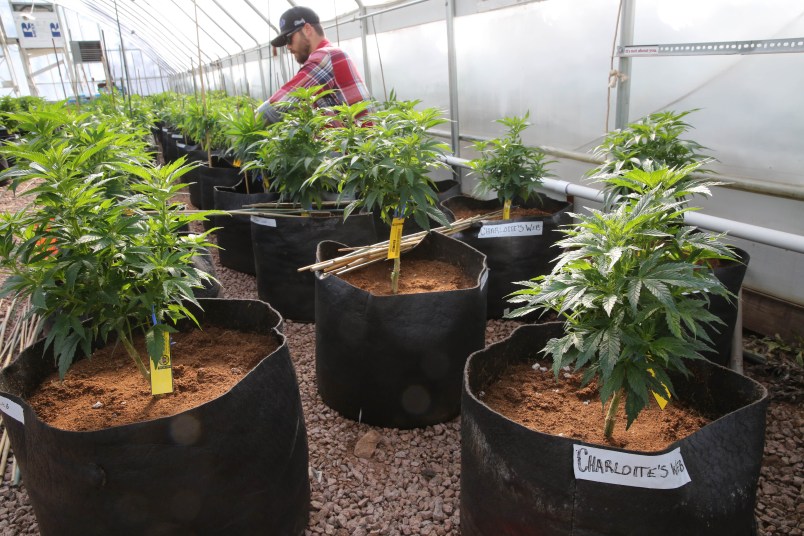This week, President Obama discussed some of the most pressing global matters of our time: ISIS, climate change, nuclear deals, and…weed. As in, he begrudgingly discussed the potential federal legalization of marijuana. I say begrudgingly, because the president made it clear that he thinks young people these days have misplaced their priorities. Instead of thinking about marijuana, they should be thinking about things like climate change.
The president is correct. Not just young folks, but all of us, should be thinking about climate change and disruption. Through our continued apathy, the atmosphere now contains unprecedented levels of carbon dioxide, methane and nitrous oxide, resulting in increases in atmospheric and oceanic temperature, more intense storms, melting ice caps, acidifying oceans and rising sea levels, which threatens our very existence.
But what if we think about the climate and marijuana at the same time?
By some estimates, indoor marijuana cultivation is accountable for producing some 15 million metric tons of carbon emissions annually—the equivalent to the amount of emissions produced by three million American cars. Put another way, one single kilogram of processed marijuana is responsible for the same amount of emissions as driving a 44 mpg car across the country five times. How can this be? It’s due in most part to the significant amount of electricity required to grow marijuana indoors.
With $6 billion in annual energy costs, the indoor marijuana industry is one of the most, if not the most, energy-intensive industry in the United States. It requires a large amount of electricity to power high-intensity heat lamps, to regulate temperature and humidity levels, and for ventilation, among other things. This energy consumption, which is expected to grow as the industry grows, results in significant greenhouse gas emissions.
Under clandestine operations, indoor cultivators use inefficient and carbon dioxide-spewing on-site diesel and gasoline generators to meet their electricity needs. As states legalize indoor marijuana cultivation, producers will connect to the grid, thereby eliminating the need to use on-site generators. Unfortunately, connecting to the grid will do little to alleviate marijuana’s impacts on the climate given that at least two-thirds of the electricity transported on the grid is generated by the burning of fossil fuels such as coal and natural gas. Legalization will, however, provide policymakers with an opportunity to assess the industry’s energy usage and evaluate its climate risks.
One way to ensure that the industry does not further contribute to an already dire situation is to require indoor marijuana cultivators to utilize only carbon-free electricity as a condition of licensing. Before you dismiss that as crazy talk, Boulder City and Boulder County in Colorado have done just that. To obtain and maintain, a license in Boulder, an indoor cultivator must obtain its energy from a renewable source. Cultivators can utilize on-site renewable generation, such as rooftop solar panels; subscribe to the Community Solar Garden; or find some other approved equivalent source.
Opponents may argue that this type of requirement is too expensive for cultivators and that it will encourage illicit operations. No doubt public policymakers need to be careful in their restrictions so as to not cause unintended results. However, requiring indoor cultivators to use only climate-friendly electricity is unlikely to have this negative effect. First, gasoline and diesel generators are inefficient and expensive to run. It is unlikely that these on-site generators would be more cost effective than utilizing renewable energy.
Second, if the lifting of Prohibition is any indicator, it’s unlikely that the increased requirement would result in continued or increased clandestine operations. After Prohibition, the alcohol industry became a highly regulated as well as a highly lucrative industry with few illegal operations. Likewise, legitimate marijuana cultivators stand to make significant profits by maintaining their licenses.
I don’t mean to unfairly single out the billion-dollar marijuana industry for bearing this extra burden while other industries get off scot-free. The indoor marijuana industry just provides a good example of the need for a climate risk assessment prior to licensing, and an opportunity for public policymakers to make a difference when starting from a clean slate. The marijuana industry is already on its way to becoming a highly-regulated industry. It already requires stakeholders to jump through many hoops on the way to licensing. I simply encourage policymakers to consider one higher priority: the use of climate-friendly electricity.
Gina S. Warren is an Associate Professor at Texas A&M University School of Law. This Op-ed is based on her article entitled, “Regulating Pot to Save the Polar Bear: Energy and Climate Impacts of the Marijuana Industry,” which will appear in Volume 40 of the Columbia Journal of Environmental Law (2015).










Make it legal and folks can grow their own outdoors. Problem solved. After all, The Good Lord put it on this earth…
The authors basis for assuming that MJ cultivation is such an energy hog really needs a bit more illumination than “By some estimates, indoor marijuana cultivation is …”.
She goes on to delineate MJ cultivation involving generators etc where, again, she offers no means of assessing the issue. Indeed, no mention is made of tech innovations which promise to dramatically reduce the carbon footprint of MJ cultivation.
I question TPM’s rationale for posting the piece.
The pic with the article is of a greenhouse. A lot of the stated energy uses don’t apply.
They won’t, however. Or at least not for a very long time. The ability to control the growth cycle of the plants, and thus vastly improve its quality, is just far too enticing.
But nobody ever bitches about all the greenhouses growing flowers in the world, which are just as big, if not a bigger drain on energy. And NOBODY is posting articles talking about the flagrant waste of gasoline and oil used in NASCAR.
The prison-industrial complex is getting very worried now that marijuana is rapidly approaching the tipping point of national legalization. Its going to be an interesting battle between them and the Big Money folks that want to start profiting from its recreational sale.
Yes, in my older age, I find myself becoming highly skeptical of people who start tossing out facts with questionable backing… like facts that are impossible to prove because they aren’t reported.
But its been long known that law enforcement tracks and targets residential properties that have suspiciously large electric and water bills. So while the “facts” being presented are questionable, indoor growing does consume a great deal of power.